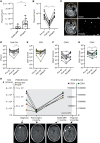Circulating extracellular vesicles as biomarker for diagnosis, prognosis, and monitoring in glioblastoma patients
- PMID: 38567448
- PMCID: PMC11226867
- DOI: 10.1093/neuonc/noae068
Circulating extracellular vesicles as biomarker for diagnosis, prognosis, and monitoring in glioblastoma patients
Abstract
Background: Extracellular vesicles (EVs) obtained by noninvasive liquid biopsy from patient blood can serve as biomarkers. Here, we investigated the potential of circulating plasma EVs to serve as an indicator in the diagnosis, prognosis, and treatment response of glioblastoma patients.
Methods: Plasma samples were collected from glioblastoma patients at multiple timepoints before and after surgery. EV concentrations were measured by nanoparticle tracking analysis and imaging flow cytometry. Tumor burden and edema were quantified by 3D reconstruction. EVs and tumors were further monitored in glioma-bearing mice.
Results: Glioblastoma patients displayed a 5.5-fold increase in circulating EVs compared to healthy donors (P < .0001). Patients with higher EV levels had significantly shorter overall survival and progression-free survival than patients with lower levels, and the plasma EV concentration was an independent prognostic parameter for overall survival. EV levels correlated with the extent of peritumoral fluid-attenuated inversion recovery hyperintensity but not with the size of the contrast-enhancing tumor, and similar findings were obtained in mice. Postoperatively, EV concentrations decreased rapidly back to normal levels, and the magnitude of the decline was associated with the extent of tumor resection. EV levels remained low during stable disease, but increased again upon tumor recurrence. In some patients, EV resurgence preceded the magnetic resonance imaging detectability of tumor relapse.
Conclusions: Our findings suggest that leakiness of the blood-brain barrier may primarily be responsible for the high circulating EV concentrations in glioblastoma patients. Elevated EVs reflect tumor presence, and their quantification may thus be valuable in assessing disease activity.
Keywords: blood; exosome; glioma; methylation; tetraspanin.
© The Author(s) 2024. Published by Oxford University Press on behalf of the Society for Neuro-Oncology. All rights reserved. For commercial re-use, please contact reprints@oup.com for reprints and translation rights for reprints. All other permissions can be obtained through our RightsLink service via the Permissions link on the article page on our site—for further information please contact journals.permissions@oup.com.
Conflict of interest statement
The authors declare no conflict of interest.
Figures





References
-
- Stupp R, Mason WP, van den Bent MJ, et al.; European Organisation for Research and Treatment of Cancer Brain Tumor and Radiotherapy Groups. Radiotherapy plus concomitant and adjuvant temozolomide for glioblastoma. N Engl J Med. 2005;352(10):987–996. - PubMed
-
- Westphal M, Lamszus K.. Circulating biomarkers for gliomas. Nat Rev Neurol. 2015;11(10):556–566. - PubMed
-
- Andre-Gregoire G, Bidere N, Gavard J.. Temozolomide affects extracellular vesicles released by glioblastoma cells. Biochimie. 2018;155:11–15. - PubMed
Publication types
MeSH terms
Substances
Grants and funding
LinkOut - more resources
Full Text Sources
Medical

